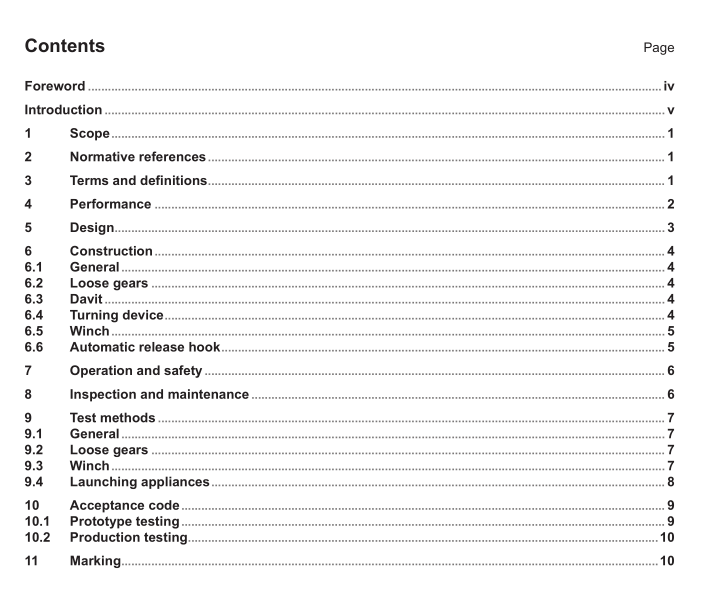ISO 13122 pdf download

ISO 13122 pdf download Ships and marine technology — Launching appliances for davit-launched liferafts
6 Construction6.1General
A launching appliance generally consists of loose gears, davit,turning gear,winch and automatic releasehook,etc. It may be specifically designed for launching and recovering the liferaft, or as a combined launchingappliance for multi-purpose functions, as long as those functions do not interfere with each other. Whateverthe design, all relevant requirements for launching or recovering the liferaft are to be met by the launchingappliance for conformance with this lnternational Standard.
Launching appliances shall be ready for immediate use at all times.
6.2Loose gears
6.2.1 The falls used for hoisting and lowering the liferaft shall be rotation-resistant and of galvanized steel wirerope or others having high resistance to corrosion.
6.2.2Falls shall be long enough so that at least three dead turns of rope remain on the winch’s drum after theliferaft has been successfully lowered to the water, with the ship in its lightest seagoing condition and under theunfavourable conditions of a trim of up to 10°and list of up to 20° either way.
6.2.3 The sheave diameter at the bottom of the sheave groove shall be at least 12 times the diameter of thefalls, and the depth of the sheave groove shall be at least 1,5 times the diameter of the falls.
A sheave cover with a small clearance between cover and sheave shall be provided to prevent the falls fromcoming out of the sheave groove.
6.3Davit
6.3.1During turning-out of the davit to the full outboard position and with the ship under the unfavourableconditions of a trim of up to 10° and list of up to 20°either side, the davit arm and frame and their fittings shall beof sufficient strength to withstand a dynamic load caused by a lowering and braking of 1,1 times the maximumworking load, and shall be able to withstand a static load of 2,2 times the maximum working load with thelaunching appliance in the worst-case trim and list conditions.
6.3.2 The davit arm shall be so arranged that it has sufficient outreach to successfully lower the liferaft in afully inflated condition to the water.
6.4Turning device
6.4.1 The turning device may be designed to be power-driven or to be driven by stored mechanical power ormanpower, nevertheless, all launching appliances shall be fitted with a turning device that can at least be drivenby manpower. In turning out, the davit arm shall bring the non-loaded liferaft it serves to full outboard with theship under unfavourable conditions of trim and list.
6.4.2Where the turning device is power-driven, it shall be fited with a brake in order to stop the turning davitarm at the prescribed position with the ship under unfavourable conditions of trim and list.
6.5Winch
6.5.1 A winch may be designed to be electrically, hydraulically or pneumatically powered, or to be driven bymanpower.
6.5.1.1 Where driven by manpower, the rotation radius of the handles or hand wheels of the winch shall benot more than 500 mm and the continuance force for hand operation shall not exceed 160 N, unless othenwisestipulated by a relevant authority.
6.5.1.2 Electrical drives and control equipment shall conform to the requirements of IEC 60092.Deck-mountedenclosures of motors and controller shall conform to lEC 60529,IP56.
6.5.1.3 Hydraulic drives and control equipment shall conform to the requirements of ISO4413.System nominalpressures shall be selected from lSo 2944, and the drive shall operate satisfactorily at a pressure 10 % belowthe selected nominal pressure.
6.5.1.4 Pneumatic drives and control equipment shall conform to the requirements of lSO 4414.Systemnominal pressures shall be selected from ISo 2944, and the drive shall operate satisfactorily at a pressure 10 %below the selected nominal pressure.
6.5.2 Each winch shall be fitted with brakes capable of stopping the descent of a fully loaded liferaft at themaximum lowering speed and of holding it securely. The winch brake shall be of sufficient strength to withstanda static load of 1,5 times the maximum working load and a dynamic load produced by braking at 1,1 times themaximum working load at the maximum lowering speed.
The brake used for controlling the lowering of the liferaft shall be so designed as to be always applied unlessheld in the “OFF” position by the operator. Brake pads shall, where necessary, be protected from water and oil.
6.5.3 The transmission case of a winch shall be so arranged within an enclosure that only minimum dailymaintenance is required.A winch’s gears and bearings shall be well lubricated with the ship under unfavourableconditions of trim and list.
6.5.4 Each winch shall be fitted with a one-way clutch or other equivalent device to make the winchautomatically disengage from the motor when the liferaft is lowered by gravity.
6.5.5 Each winch shall be fitted with a speed regulator to control the lowering speed of the liferaft when theliferaft is lowered by gravity.
6.5.6 The nominal diameter of the drum shall be not less than 16 times the diameter of the wire rope.The outeredges of the drum’s flanges shall be at least 1,5 times the diameter of the wire rope beyond the top layer of rope.
6.5.7 Apowered winch shall be fitted with a hand gear for hoisting the non-loaded liferaft it serves in the eventof a power failure.
6.5.8 Where the winch serves to launch several liferafts, it shall be fitted with an additional manual device forrapid recovery of the non-loaded hook.









